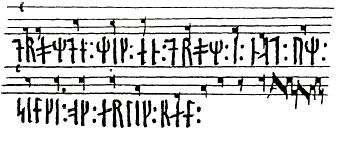Drømde mik en drøm i nat
Drømde mik en drøm i nat is the oldest known secular song in the Nordic countries, written around 1300. It is written in Old East Norse and is included in Codex Runicus, a transcript of Scanian Law where it forms a final note. Like the law itself, it is written in runes, and the tune is written on two simple staves in an early form of musical notation.[1] The song is sung in episode 6 of Vikings.
Song text
The text of the song is
- Drømde mik en drøm i nat um
- silki ok ærlik pæl
There are several interpretations of the text, as the meaning of the words silki and ærlik pæl is obscure. Traditionally, most interpretations have been variants on these readings:
- I dreamt a dream last night of silk and fine fur
- I dreamt a dream last night of silk and expensive cloth
This interpretation takes the 13th-century word silki to mean silk. It may be compared with the medieval song "Palle Boosons visa" which also speaks of "silk and fine fur": "Han kläder sig i silke, så och i ädel päll..".[2]
This interpretation has been called into question, because it fails to take account of the context of the document.[3] Codex Runicus is a lawbook that ends with a text of marginal notes. Since the song appears to be written in the same hand that completed the main body of the manuscript, it would seem more appropriate if the lyrics of the song were connected with the content of the document. One would expect a text concerning law and order rather than luxury. However, there are many examples of similar insertions of unrelated text into medieval European documents, a particularly notable one being the Old Irish poem Pangur Bán.
Alternative interpretations that better fit with this understanding of the song's context are:
- I dreamt a dream last night of justice and fair play
- I dreamt a dream last night of equality and honest measure
The word silki could be seen as related to the old Nordic word slik meaning equality or the same as.[4] Likewise, Ærlik pæl could be "honest measure", since pæl and pel, are old words for "measure", cognate with German Pegel.[5] Ærlik is used meaning "honest" (cf. "ærlig" in Modern Danish) on the very first page of the Codex Runicus.
Musical notes
Whilst there is general agreement on the notes of the melody (except for ligatures), a variety of rhythmical interpretations are possible.[6]
Tobias Norlind believed it to be an early version of Staffansvisan, a song about Saint Stephen which is known in several versions and is used in annual rites. However, Norlind did not attempt to interpret the rhythmical structure of the song.
For many years, a version of the tune was used in breaks between programmes on Danmarks Radio.
In this version, the first half of the tune has been interpreted as trochee:
Another interpretation based on rhythmical structures common in older traditional music, gives us a standard dance tune consisting of four plus four bars:[7]
References
| Wikimedia Commons has media related to Drømte mig en drøm i nat. |
- ↑ "Drømde mig en drøm" (in Danish). University of Copenhagen. Retrieved 2009-08-03.
- ↑ Adolf Iwar Arwidsson, Svenska Fornsånger, första delen sid 199, in swedish
- ↑ Åke Persson och Johannes Holmqvist, Runtenom 2003-4 sid 6 (in Swedish)
- ↑ Corpus iuris Sueo-Gotorum antiqui: Samling af Sweriges gamla lagar, pages 288, 294, 314, 319, in Swedish
- ↑ German Wikipedia: Pegel (Wasserstandsmessung)
- ↑ More interpretations are found at FolkWiki
- ↑ Åke Persson, Runtenom 2000-1 sid 7, in swedish


